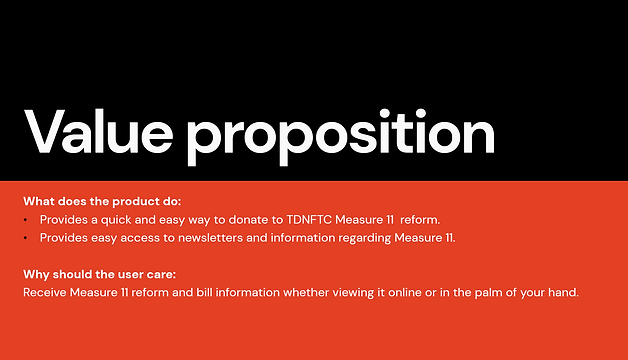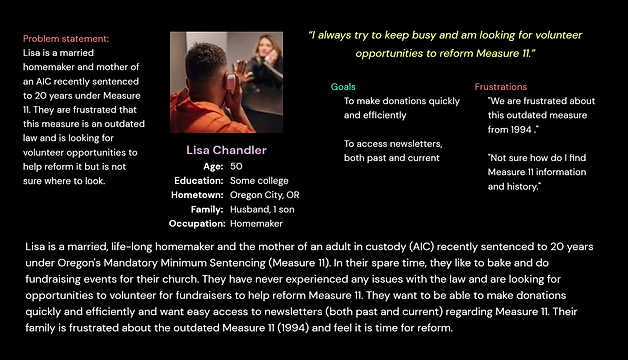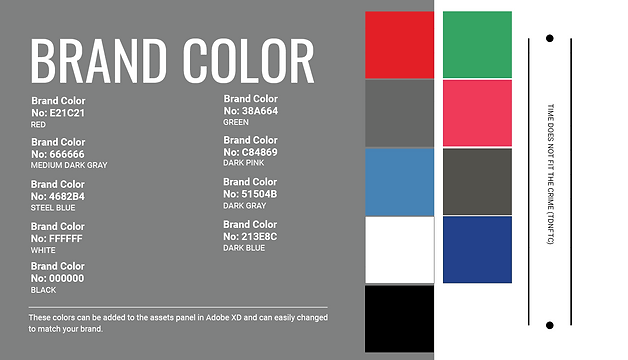Time Does Not Fit The Crime (TDNFTC)
Stepping In at the Critical Moment: Amplifying the Fight for Fair Sentencing
Project Type: High-Fidelity Advocacy Platform Design (UX/UI + Web Build + Brand Integration)

Project overview
TDNFTC was an Oregon-based nonprofit advocating for equitable sentencing reform, particularly the repeal of Measure 11 mandatory minimums. The organization urgently needed a website to educate the public, empower families, and mobilize support — but their original designer dropped off days before launch. I stepped in to lead the user experience, build the site from scratch, align it with their existing advocacy branding, and develop supporting communications assets. The result: a responsive, accessible digital hub that amplified their mission, increased community engagement, and supported statewide reform efforts.
Role: Sole UX Designer & Webmaster, Chief Communications Officer
Deliverables: Design system, website, orientation slide deck, newsletters, brochures, business cards
Tools: XD, Adobe Creative Suite, Google Workspace, Pitch, Wix
Industry: Nonprofit, Prison Reform, Social Justice
Duration: 9/15–11/4/2021 (initial launch) + Ongoing brand and communication work through 12/31/2023
Objectives
-
Launch a responsive, accessible website before public announcement deadline
-
Present credible information on Measure 11 and reform efforts
-
Empower users to donate, volunteer, subscribe, and engage in advocacy
-
Create unified communication + design assets across digital and print

Design approach
Rooted in Justice-Driven Storytelling
The design approach for TDNFTC centered around creating a digital space grounded in transparency, dignity, and action. Rather than simply presenting information, the experience needed to guide users through a complex and emotionally charged issue with clarity and empathy. I focused on human-first communication, prioritizing accessible language, intuitive navigation, and compelling calls to action that empowered visitors to learn, participate, and advocate.

Process work
Research & discovery
To ground the project in real needs and lived experiences, I began with interviews with the CEO and COO to fully understand TDNFTC’s mission, goals, and operational capacity. From there, I mapped key audience groups — families impacted by Measure 11, community advocates, potential donors, and returning citizens — to uncover what information they needed most. Users were primarily seeking clear access to the history of Measure 11, updates on reform efforts, and actionable ways to get involved. Establishing this foundation ensured that every design decision supported transparency, dignity, and meaningful engagement.
Competitive audit
To understand the advocacy landscape, I evaluated leading justice-focused organizations including The Sentencing Project, Brennan Center for Justice, and Families Against Mandatory Minimums. While each offered valuable information, few provided a localized, action-oriented resource specifically focused on Oregon’s Measure 11. This revealed an opportunity to create a space that not only informed users but also empowered them to participate directly in state-level advocacy and reform.

Goal statements & design goals
After diving into the research phase, it became clear that our users had four primary intentions:
-
learn the history and impact of Measure 11,
-
access and subscribe to newsletters,
-
explore volunteer opportunities, and
-
make meaningful donations to support reform efforts.
These insights informed our product goals, guiding us to prioritize clarity, accessibility, and pathways for meaningful advocacy. By aligning design decisions with what users needed most, we ensured the website supported education, engagement, and sustained involvement in the reform movement.
Working closely with the CEO and COO, I then translated these needs into clear project goals and co-crafted a strong value proposition that communicated purpose, built trust, and inspired action.


User personas & problem definition
With the project goals defined, I developed a primary persona representing individuals and families most affected by Measure 11. This persona captured key motivations, emotional drivers, and engagement barriers, helping humanize the user journey and guide design decisions.
Understanding their challenges and aspirations allowed me to shape messaging and navigation that felt welcoming, empowering, and intuitive. The persona reinforced the platform’s core goals: offer clarity around a complex legal issue, build trust through transparency, and reduce cognitive and emotional load during an already difficult process.
The outcome was a focused experience designed to inform, empower, and activate users to engage in justice reform with clarity and confidence.
Information architecture
Using the research insights, I translated user needs into a clear, matrix-style site structure that allowed visitors to explore freely or follow a guided path. Key content categories — Facts, About Us, Latest News, and Get Involved — ensured high-priority information was accessible without friction. Each section was intentionally named and organized using audience-friendly language rather than institutional or legal terminology, making complex information approachable and building confidence for users navigating a sensitive and emotionally heavy topic.


Visual design development
The visual direction balanced urgency, credibility, and hope. Bold reds and pinks echoed existing Reform Measure 11 advocacy materials, while blues, grays, and clean typography reinforced trust and professionalism.

Avenir was chosen for its modern feel and reliable readability across devices. The goal was to create visual energy without overwhelming the emotional weight of the topic — grounding the mission in strength, transparency, and dignity.

Prototyping
Given the tight project timeline, I designed responsive layouts directly in Wix, allowing the live build to function as a working prototype. Designing in-platform enabled rapid iteration within real device constraints and ensured the experience translated seamlessly across screen sizes.


Testing
I conducted moderated usability tests to observe how users navigated the site and engaged with content, then incorporated feedback in real time. This approach allowed me to move quickly, validate decisions early, and refine the interface to keep it intuitive, accessible, and grounded in user needs.

Challenges & solutions
Challenge: Original designer dropped pre-launch.
Solution: Took over full UX + build + testing, delivered before public reveal.
Challenge: Complex legal content.
Solution: Simplified language, layered info, CTA-driven structure.
Challenge: Multiple audiences.
Solution: Research-driven navigation + persona to guide choices.
Challenge: Brand consistency.
Solution: Matched existing merch palette + tone to create unified identity.
Deliverables
-
UX architecture + site map + responsive website
-
Style tile
-
Newsletter templates (email + print) + banners
-
Business cards w/ QR codes




Outcome & reflection
-
🚀 Website launched by deadline (November 4, 2021)
-
📈 +27% traffic increase by March 2023
-
👥 Growth in newsletter engagement, volunteers, and donations
-
🤝 Direct positive impact on advocacy and community engagement
-
💼 Promoted from Public Relations Coordinator to Chief Communications Officer & Webmaster
-
💰 Secured $20,000 grant for Measure 11 reform efforts (Yarg Foundation's 2022 Justice Reform Initiative Grant)
The project blended UX, ethical storytelling, and mission-driven design — helping empower families, educate the public, and support real policy change.
Final thoughts
Designing for a justice-system-impacted audience taught me to work with deep empathy and urgency. Access to information isn’t just UX — it’s dignity, safety, and agency.
This work reinforced my belief that design can bridge people to resources, amplify unheard voices, and strengthen movements for social change.
Even as the organization closed in late 2023, the foundation we built served real people, real families, and real hope — and I'm proud of the role design played in that impact.
Note
TDNFTC officially dissolved December 31, 2023.
Website remains live for reference + transparency.